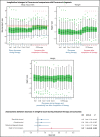Changes in body mass index, weight, and height in children with acute myeloid leukemia and the associations with outcome
- PMID: 35196375
- PMCID: PMC9092412
- DOI: 10.1182/bloodadvances.2021006090
Changes in body mass index, weight, and height in children with acute myeloid leukemia and the associations with outcome
Abstract
Little is known about body composition changes in patients with acute myeloid leukemia (AML) during and after treatment or their associations with outcomes. Z-scores for body mass index (BMI), weight, and height at diagnosis, their longitudinal changes from diagnosis to 5 years off therapy, and their associations with adverse effects and outcomes were evaluated in 227 pediatric patients with AML enrolled in the AML02 and AML08 trials at St. Jude Children's Research Hospital between 2002-2017. The median Z-scores for baseline weight, height, and BMI were 0.193, 0.209, and 0.170, respectively, and those for weight and height decreased significantly during therapy to -0.038 and -0.163, respectively, at off-therapy (P < .001 for both). At 5 years off therapy, the Z-scores for weight and BMI had increased significantly to 0.492 (P = .003) and 0.911 (P < .001), respectively, whereas the height Z-score remained significantly lower at -0.066 (P < .001) compared with baseline. The height Z-score of transplant recipients decreased further from -0.211 at transplant to -0.617 12 months later (P < .001). Baseline BMI category and Z-score were not associated with outcomes, but higher weight Z-scores were associated with lower incidences of refractory or relapsed disease (hazard ratio [HR], 0.82; 95% confidence interval [CI], 0.67-0.99) and higher incidences of death in remission (HR, 1.31; 95% CI, 1.01-1.70). Furthermore, weight Z-score decrease during induction therapy was associated with gastrointestinal, hepatic, and infection toxicities during subsequent therapy and with death in remission (HR, 2.66; 95% CI, 1.11-6.45). Multidisciplinary monitoring for weight changes and short stature is required from diagnosis to the off-therapy period.
© 2022 by The American Society of Hematology. Licensed under Creative Commons Attribution-NonCommercial-NoDerivatives 4.0 International (CC BY-NC-ND 4.0), permitting only noncommercial, nonderivative use with attribution. All other rights reserved.
Figures





Similar articles
-
Longitudinal changes in body mass index, height, and weight in children with acute myeloid leukemia.BMC Pediatr. 2024 Apr 30;24(1):293. doi: 10.1186/s12887-024-04740-z. BMC Pediatr. 2024. PMID: 38689235 Free PMC article.
-
Changes in body mass index, height, and weight in children during and after therapy for acute lymphoblastic leukemia.Cancer. 2018 Nov 1;124(21):4248-4259. doi: 10.1002/cncr.31736. Epub 2018 Oct 25. Cancer. 2018. PMID: 30358906 Free PMC article. Clinical Trial.
-
Treatment with highly active antiretroviral therapy in human immunodeficiency virus type 1-infected children is associated with a sustained effect on growth.Pediatrics. 2002 Feb;109(2):E25. doi: 10.1542/peds.109.2.e25. Pediatrics. 2002. PMID: 11826235
-
Association of Birth Weight, Childhood Body Mass Index, and Height With Risk of Hidradenitis Suppurativa.JAMA Dermatol. 2020 Jul 1;156(7):746-753. doi: 10.1001/jamadermatol.2020.1047. JAMA Dermatol. 2020. PMID: 32347905 Free PMC article.
-
[Simple obesity in children. A study on the role of nutritional factors].Med Wieku Rozwoj. 2006 Jan-Mar;10(1):3-191. Med Wieku Rozwoj. 2006. PMID: 16733288 Review. Polish.
Cited by
-
Parent/caregiver's role in nutrition, physical activity, and food access among children diagnosed with spina bifida.J Pediatr Rehabil Med. 2023;16(4):639-647. doi: 10.3233/PRM-230016. J Pediatr Rehabil Med. 2023. PMID: 38160371 Free PMC article.
-
Celebrating a year of clinical and translational research in Blood Advances.Blood Adv. 2022 Dec 27;6(24):6271-6273. doi: 10.1182/bloodadvances.2022009151. Blood Adv. 2022. PMID: 36574267 Free PMC article. No abstract available.
-
Longitudinal changes in body mass index, height, and weight in children with acute myeloid leukemia.BMC Pediatr. 2024 Apr 30;24(1):293. doi: 10.1186/s12887-024-04740-z. BMC Pediatr. 2024. PMID: 38689235 Free PMC article.
-
Impact of body mass index at diagnosis on outcomes of pediatric acute leukemia: A systematic review and meta-analysis.PLoS One. 2024 May 6;19(5):e0302879. doi: 10.1371/journal.pone.0302879. eCollection 2024. PLoS One. 2024. PMID: 38709714 Free PMC article.
References
Publication types
MeSH terms
Grants and funding
LinkOut - more resources
Full Text Sources
Medical

